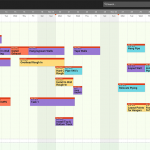As reported last week in Construction Dive, the Q2 2018 United States Gypsum (USG) + U.S. Chamber of Commerce Commercial Construction Index (CCI) expressed widespread concern among contractors about their ability to hire enough skilled labor to properly staff projects.
According to the index, nine out of ten contractors are concerned about the industry labor shortage, and forty-seven percent expect the situation to get worse—not better—over the next six months. The trades currently in shortest supply are concrete, electrical, drywall and steel erection workers.
At the same time, contractors expressed high levels of confidence overall, with ninety-six percent expecting the demand for construction services to increase over the next year.
Confidence in the industry’s financial conditions was similarly high. Eighty percent of contractors expect access to working capital financing to remain the same or expand, and seventy percent expect owner access to financing to remain stable or improve in the next six months.
When Confidence Is a Bad Sign
It isn’t hard to see where this is going. The combination of increased demand for construction services and easy access to financing is likely to exacerbate the labor shortage as more projects are won than contractors are able to staff. This is likely to drive up labor costs, already an area of moderate concern to eighty-seven percent of contractors. In addition to driving up costs, the shortage of skilled labor is also likely to cause delays in project completion.
These converging trends highlight the need for contractors to explore options other than engaging in endless bidding wars or trying to clone electricians. By finding ways to work more efficiently, projects can be completed on schedule with fewer personnel.
This Can Only Lean One Thing
The adoption of Lean principles has emerged as a popular method of increasing operational efficiency and minimizing waste within the construction industry. Implementing the Last Planner® System, in particular, has helped many contractors compensate for unfavorable market conditions. The Last Planner® is a production planning system that organizes work schedules to minimize waste in time, materials and personnel. The term “last planner” refers to the individuals in charge of doing the work on-site, because they are the last ones to finalize the details of the plan. Because they perform the work, they know better than anyone else how to plan it, and by getting all of a project’s last planners in a room together they can coordinate the details of all of their work so they don’t interfere with each other’s tasks.
A core component of the Last Planner® System is pull planning, so called because the work is “pulled” from the various teams involved and planned backwards. Pull planning is integral to Lean construction because by planning backwards and involving all the teams, the phase schedules created are based on a team’s best thinking and make optimal use of time and materials by thoughtfully sequencing work. When the Last Planner® System is implemented properly, trades arrive to sites that are ready for them because the team ahead of them completed their work on time. In traditional construction, over fifty percent of the time a trade will show up to an area and be unable to start because someone is in the way or something isn’t done yet.
Traditionally, pull planning has been conducted in meetings in which teams mark tasks out using sticky notes on a whiteboard or a wall. The problem with this approach is that it requires considerable time and effort to implement and uphold, particularly on complex projects with many teams involved. Because of the complexity of the resulting plans, doing any kind of analysis to learn from and improve the plan requires that the results be loaded in a computer. Any effort put forward by a few individuals to enter the data in on behalf of the rest of the team not only duplicates effort, but also disconnects the last planners from their plan. This disconnect can lead to misunderstandings and miscommunication later on.
Digital Pull Planning
To address the shortcomings of analog pull planning, many contractors are turning to Touchplan, a digital tool for Lean construction project scheduling. Use of a digital tool gives an organization visibility into how well the Last Planner® System is being implemented across all their projects. This visibility enables them to give projects (and people) the right kind of attention based on what they’re doing well (or where they need improvement).
Using Touchplan’s SaaS solution, everyone involved in the project can collaborate on the schedule in real time and update it when needed so that the plan is always kept current. This cuts waste out of meetings so teams can spend their time planning, learning and improving rather than maintaining the plan and debating who said what, when.
By using a digital pull planning tool, contractors can optimize their schedules and ensure that work is done in the most efficient way possible. By scheduling smarter, they save money that might have been wasted on delays and rework, and they can maximize the productivity of their workforce by knowing exactly when to bring them on the jobsite. And while Touchplan can’t solve the labor shortage, it enables contractors to do more with the labor they have and save money to hire the labor they need.










